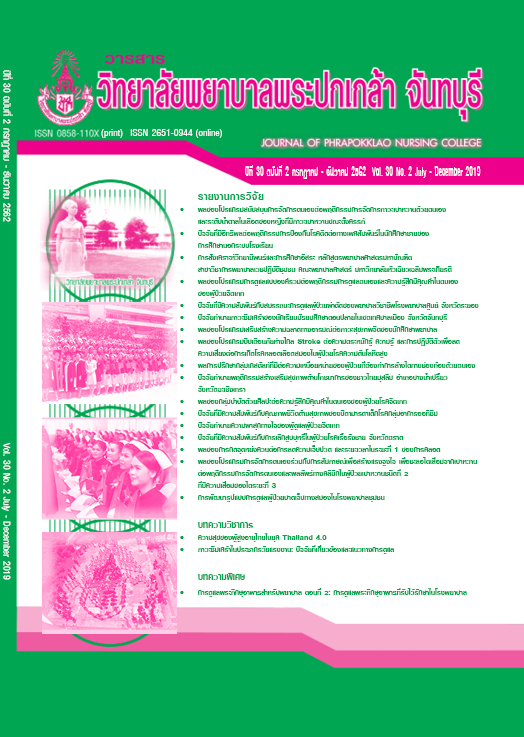Predictive Factors of Depression among High School Students of Municipality, Chanthaburi
Keywords:
Depression, Family connectedness, Negative life event, Internet addiction, Resilience, High school studentAbstract
This predictive correlational research aimed to determine depression and factors influencing depression among high school students. The samples consisted of 160 high school students in municipality, Chanthaburi Province in an academic year of 2017. The research instruments included a demographic questionnaire, a family connectedness questionnaire with the reliability of .75, the negative life event scale with the reliability of .93, an internet addiction questionnaire with the reliability of .84, a resilience inventory questionnaire with the reliability of .88, and a depression questionnaire with the reliability of .82. Data were collected from July to August, 2017. Statistics used for data analysis included frequency, percentage, mean, standard deviation, Pearson’s product moment correlation coefficient, and stepwise multiple regression.
The research results revealed that 95.70% of high school students had no depression, whereas the overall mean score of depression was 12.32 (SD = 4.87). Internet addiction and resilience could statistically significant predict depression by 32.50% (R2 = .325, p < .001). Resilience was the highest predictor of depression (Beta = -.492, p < .001) followed by internet addiction (Beta = .225, p < .01).
This research suggests that health care providers should apply these research results for preventing depression among high school students focusing on strengthening resilience and preventing internet addiction in order to promote good mental health.
References
จิณห์จุฑา ชัยเสนา ดาลลาส, สายใจ พัวพันธ์, และดวงใจ วัฒนสินธุ์. (2558). ปัจจัยที่มีอิทธิพลต่อภาวะสุขภาพจิตของนักศึกษาพยาบาล. วารสารคณะพยาบาลศาสตร์ มหาวิทยาลัยบูรพา, 23(3), 1-13.
ฐิตวี แก้วพรสวรรค์, และเบญจพร ตันตสูติ. (2555). การศึกษาความชุกของภาวะซึมเศร้าและปัจจัยที่เกี่ยวข้องในเด็กนักเรียนชั้นมัธยมศึกษาปีที่ 5 ในกรุงเทพมหานคร. วารสารสมาคมจิตแพทย์แห่งประเทศไทย, 57(4), 395-402.
ฐิตินันท์ ผิวนิล, และพิมลพรรณ อิศรภักดี. (2558). พฤติกรรมการสื่อสารผ่านเทคโนโลยีกับภาวะสุขภาพใจของนักเรียนระดับมัธยมศึกษาในจังหวัดกาญจนบุรี. วารสารธรรมศาสตร์, 34(2), 134-149.
ณิชาภัทร รุจิรดาพร, และอุมาพร ตรังคสมบัติ. (2552). ภาวะซึมเศร้าของนักเรียนชั้นมัธยมศึกษาตอนปลายในเขตกรุงเทพมหานคร. วารสารสมาคมจิตแพทย์แห่งประเทศไทย, 54(4), 337-346.
นวลจิรา จันระลักษณะ, ทัศนา ทวีคูณ, และโสภิณ แสงอ่อน. (2558). ปัจจัยทำนายภาวะซึมเศร้าในนักเรียน ชั้นมัธยมศึกษาตอนปลาย. วารสารการพยาบาลจิตเวชและสุขภาพจิต, 29(2), 128-143.
นันทวัช สิทธิรักษ์. (2559). จิตเวช ศิริราช DSM-5 (พิมพ์ครั้งที่ 3). กรุงเทพฯ: ประยูรสาส์นไทย การพิมพ์.
พรพรรณ ศรีโสภา, ภรภัทร เฮงอุดมทรัพย์, จิณห์จุฑา ชัยเสนา ดาลลาส, และดวงใจ วัฒนสินธุ์. (2556). ประสบการณ์การใช้อินเทอร์เน็ตในนิสิตที่มีพฤติกรรมติดอินเทอร์เน็ต. วารสารคณะพยาบาลศาสตร์ มหาวิทยาลัยบูรพา, 23(4), 61-73.
พัชรินทร์ นินทจันทร์, ทัศนา ทวีคูณ, จริยา วิทยะศุภร, และพิศสมัย อรทัย. (2554). ความแข็งแกร่งในชีวิตและความเครียดของนักศึกษาพยาบาลโรงเรียนพยาบาลรามาธิบดี. วารสารการพยาบาลจิตเวชและสุขภาพจิต, 25(1), 1-13.
พัชรินทร์ นินทจันทร์, โสภิณ แสงอ่อน, และจริยา วิทยะศุภร. (2556). ความแข็งแกร่งในชีวิต เหตุการณ์ที่สร้างความยุ่งยากใจ และสุขภาพจิตของนักศึกษามหาวิทยาลัย. วารสารการพยาบาลและสุขภาพ, 7(2), 12-24.
พัชรินทร์ นินทจันทร์, โสภิณ แสงอ่อน, และทัศนา ทวีคูณ. (2555). โปรแกรมการเสริมสร้างความแข็งแกร่งในชีวิต. กรุงเทพฯ: จุดทอง.
พิทักษ์พล บุณยมาลิก, พนมศรี เสาร์สาร, และวรวรรณ จุฑา. (2550). ความชุกของภาวะซึมเศร้าในนักเรียนระดับชั้นมัธยมศึกษาตอนปลายและประโยควิชาชีพ: การสำรวจโรงเรียนและวิทยาลัยระดับชาติ ปี 2547. วารสารสมาคมจิตแพทย์แห่งประเทศไทย, 52(2), 172-180.
พิภพ จิรภิญโญ. (2551). การเรียนมัธยมปลายขณะวัยรุ่น. สืบค้นจาก satitapp.kus.ku.ac.th/guidance/story-10.html
รวิกรานต์ นันทเวช. (2550). ปัจจัยที่ส่งผลต่อพฤติกรรมการติดอินเทอร์เน็ตของนักเรียนชั้นมัธยมศึกษาตอนปลาย (วิทยานิพนธ์ปริญญาพยาบาลศาสตรมหาบัณฑิต). กรุงเทพฯ: จุฬาลงกรณ์มหาวิทยาลัย.
ลำเจียก กำธร, โสภิต สุวรรณเวลา, ประไพพิศ สิงหเสม, และสร้อยสุวรรณ พลสังข์. (2555). ความผูกพันในครอบครัว ความเชื่อที่ไร้เหตุผล และภาวะซึมเศร้า ของเด็กและเยาวชนในสถานพินิจและคุ้มครองเด็กและเยาวชน. วารสารวิทยาลัยพยาบาลพระปกเกล้า จันทบุรี, 23(1), 15-26.
วัชรินทร์ กระแสสัตย์. (2554). ความสัมพันธ์ระหว่างประเพณีครอบครัว ความผูกพันในครอบครัว กับความเข้มแข็งทางใจของวัยรุ่น จังหวัดพระนครศรีอยุธยา. วารสารสาธารณสุขมหาวิทยาลัยบูรพา, 6(2), 59-68.
วารีรัตน์ ถาน้อย, อทิตยา พรชัยเกตุ โอว ยอง, และภาศิษฏา อ่อนดี. (2555). ปัจจัยที่มีอิทธิพลต่อภาวะสุขภาพจิตของนักศึกษาคณะพยาบาลศาสตร์ มหาวิทยาลัยมหิดล. วารสารสภาการพยาบาล, 27(พิเศษ), 60-76.
วิศิษฎ์ ฉวีพจน์กำจร, ณัฐจาพร พิชัยณรงค์, วรณัน อรรถแสงศรี, ปรารถนา สถิตย์วิภาวี, และชฎาภา ประเสริฐทรง. (2559). วัยรุ่นกับภาวะซึมเศร้า: การประเมินภาวะซึมเศร้าในกลุ่มนักเรียนมัธยมศึกษาตอนปลาย จังหวัดนนทบุรี. วารสารวิทยาศาสตร์และเทคโนโลยี มหาวิทยาลัยมหาสารคาม, 35(5), 530-537.
ศรีเรือน แก้วกังวาล. (2551). จิตวิทยาพัฒนาการชีวิตทุกช่วงวัย (พิมพ์ครั้งที่ 8). กรุงเทพฯ: สำนักพิมพ์มหาวิทยาลัยธรรมศาสตร์.
สำนักข่าวอิศรา. (2560). จันทบุรีแซงขึ้นอันดับ 1 สถิติมีคนฆ่าตัวตาย- ทั้งประเทศ 4 พันคน/ปี. สืบค้นจาก https://www.isranews.org/thaireform/thaireform-news/59416-suicide_59416.html
สำนักสารนิเทศ กระทรวงสาธารณสุข. (2558). สธ.เผยไทยฆ่าตัวตาย ปีละ 3‚900 คน เตือน “สังคมออนไลน์” ระวังข้อความโพสต์ “4 อย่า 3 ควร”. สืบค้นจาก https://pr.moph.go.th/iprg/include/admin_hotnew/show_hotnew.php?idHot_new=75880
สุริยเดว ทรีปาตี. (2550). กลยุทธ์การสร้างคุณภาพวัยรุ่นไทย (Developmental assets) เอกสารวิชาการ คลินิกเพื่อนวัยทีน. กรุงเทพฯ: สถาบันสุขภาพเด็กแห่งชาติมหาราชินี.
เสาวภาคย์ แหลมเพ็ชร. (2559). พฤติกรรมและผลกระทบจากการใช้เครือข่ายสังคมออนไลน์ของนักเรียนระดับชั้นมัธยมศึกษาตอนปลายในจังหวัดนนทบุรี. สุทธิปริทัศน์, 30(93), 116-130.
อังคณา เพชรกาฬ. (2551). ปัจจัยที่มีความสัมพันธ์กับพฤติกรรมเสี่ยงทางเพศของนักเรียนมัธยมศึกษาในจังหวัดนครนายก (วิทยานิพนธ์ปริญญามหาบัณฑิต). กรุงเทพฯ: มหาวิทยาลัยมหิดล.
อาภรณ์ ศรีชัย. (2559). ความสัมพันธ์ระหว่างความผูกพันในครอบครัว เหตุการณ์ในชีวิตเชิงลบ ความฉลาดทางอารมณ์ กับภาวะสุขภาพจิตของนักเรียนมัธยมศึกษาตอนปลาย (วิทยานิพนธ์ปริญญามหาบัณฑิต). ชลบุรี: มหาวิทยาลัยบูรพา.
อุมาพร ตรังคสมบัติ, วชิระ ลาภบุญทรัพย์, และปิยลัมพร หะวานนท์. (2540). การใช้ CES-D ในการคัดกรองภาวะซึมเศร้าในวัยรุ่น. วารสารสมาคมจิตแพทย์แห่งประเทศไทย, 42(1), 2-13.
Beck, J. S. (2011). Cognitive therapy: Basics and beyond (2nd ed.). New York: Guilford.
Boonyamalik, P. (2005). Epidemiology of adolescent suicidal ideation: Roles of perceived life stress, depressive symptoms, and substance use (Doctoral dissertation). Baltimore, MD: Johns Hopkins University.
Grotberg, E. H. (1995). A guide to promoting resilience in children: Strengthening the human spirit. Retrieved from https://bibalex.org/baifa/Attachment/Documents/115519.pdf
Hill, R. G., & Shepherd, G. (2009). Disorders of mood: Depression and mania. In R. Newell & K. Gournay (Eds.). Mental health nursing: An evidence-based approach (pp. 165-186). Philadelphia: Elsevier.
Joseph, N. (2011). Prevalence of depression among pre-university college students in an urban area of South India. International Journal of Current Research, 3(11), 439-442.
Kanner, A. D., Coyne, J. C., Schaefer, C., & Lazarus, R. S. (1981). Comparison of two modes of stress measurement: Daily hassles and uplifts versus major life events. Journal of Behavioral Medicine, 4(1), 1-39.
Kaur, K. (2015). Internet addiction among adolescents in relation to depression. International Journal of Management and Applied Science, 1(9), 207-209.
Matlin, S. L., Molock, S. D., & Tebes, J. K. (2011). Suicidality and depression among African American adolescents: The role of family and peer support and community connectedness. American Journal of Orthopsychiatry, 81(1), 108-117.
National Institute of Mental Health. (2011). Depression. Washington: Government Printing Office.
Resnick, M. D., Harris, L. J., & Blum, R. W. (1993). The impact of caring and connectedness on adolescent health and well-being. Journal of Paediatrics and Child health, 29(Suppl. 1), 3-9.
Stuart, G. W. (2009). Principles and practice of psychiatric nursing (9th ed). St. Louis: Elsevier Mosby.
Tabachnick, B. G., & Fidell, L. S. (2001). Using multivariate statistics (4th ed.). Boston, MA: Allyn and Bacon.
World Health Organization. (2011). Global status report on alcohol and health. Geneva: Author.
Young, K. S. (1996). Psychology of computer use: XL. Addictive use of the internet: A case that breaks the stereotype. Psychological Reports, 79(3 Pt 1), 899-902.
Ziaian, T., de Anstiss, H., Antoniou, G., Baghurst, P., & Sawyer, M. (2012). Resilience and its association with depression, emotional and behavioural problem, and mental health service utilisation among refugee adolescents living in South Australia. Retrieved from https://www.hindawi.com/journals/ijpr/2012/485956/
Ziaian, T., de Anstiss, H., Antoniou, G., Sawyer, M., & Baghurst, P. (2012). Depressive symptomatology and service utilisation among refugee children and adolescents living in South Australia. Child and Adolescent Mental Health, 17(3), 146-152.
Downloads
Published
How to Cite
Issue
Section
License
Copyright (c) 2019 JOURNAL OF PHRAPOKKLAO NURSING COLLEGE

This work is licensed under a Creative Commons Attribution-NonCommercial-NoDerivatives 4.0 International License.
เนื้อความ ข้อมูล และรายการอ้างอิงที่ผู้เขียนใช้ในการเขียนบทความเพื่อลงตีพิมพ์ในวารสารวิทยาลัยพยาบาลพระปกเกล้า จันทบุรี ถือเป็นความคิดเห็นและความรับผิดชอบของผู้เขียน คณะผู้จัดทำวารสารไม่จำเป็นต้องเห็นพ้องด้วยหรือร่วมรับผิดชอบ
บทความที่ได้รับการลงตีพิมพ์ในวารสารวิทยาลัยพยาบาลพระปกเกล้า จันทบุรี ถือเป็นลิขสิทธิ์ของวารสารวิทยาลัยพยาบาลพระปกเกล้า จันทบุรี หากหน่วยงานหรือบุคคลใดต้องการนำส่วนหนึ่งหรือทั้งหมดของบทความไปเผยแพร่ต่อเพื่อวัตถุประสงค์ใด ๆ จะต้องได้รับอนุญาตจากบรรณาธิการวารสารก่อน



